It’s the 7th night for Spawn #43 which was spawned on 10-22; we’re on the night of 10-29 going into 10-30 now; there wasn’t any noticeable hatch on the tile over the 6th night (I left it with the parents yesterady)….it will get pulled. This is what Spawn #43 looked like when it was laid fresh on 10-22…I should also point out this is the first time I’ve taken pictures of the F0 original wild pair of Lightning Maroon X White Stripe PNG Maroon Clownfish.
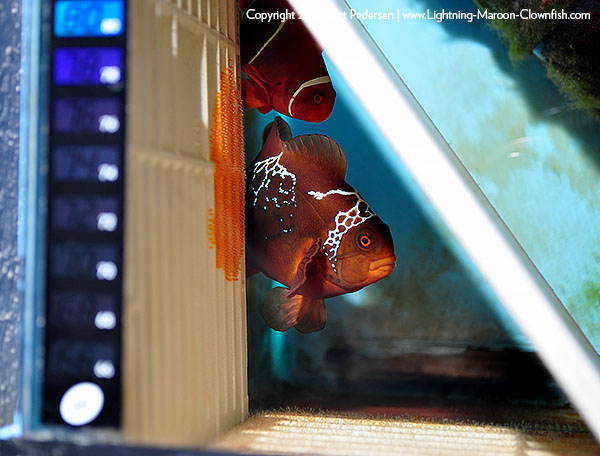
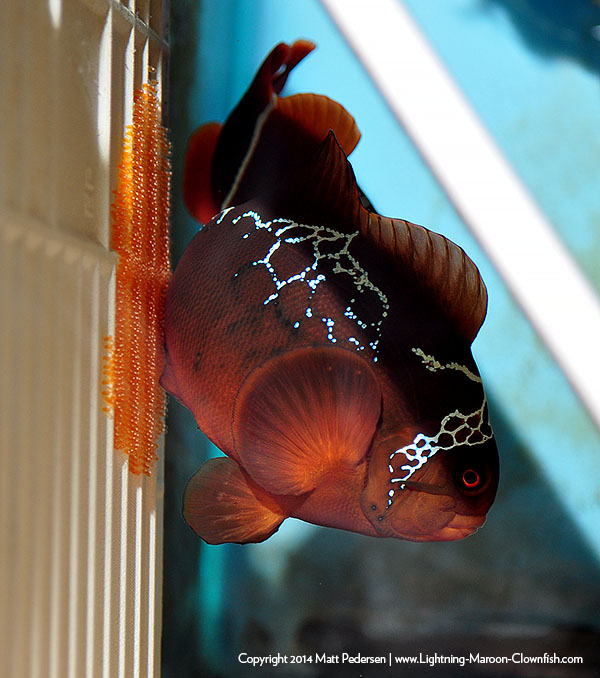
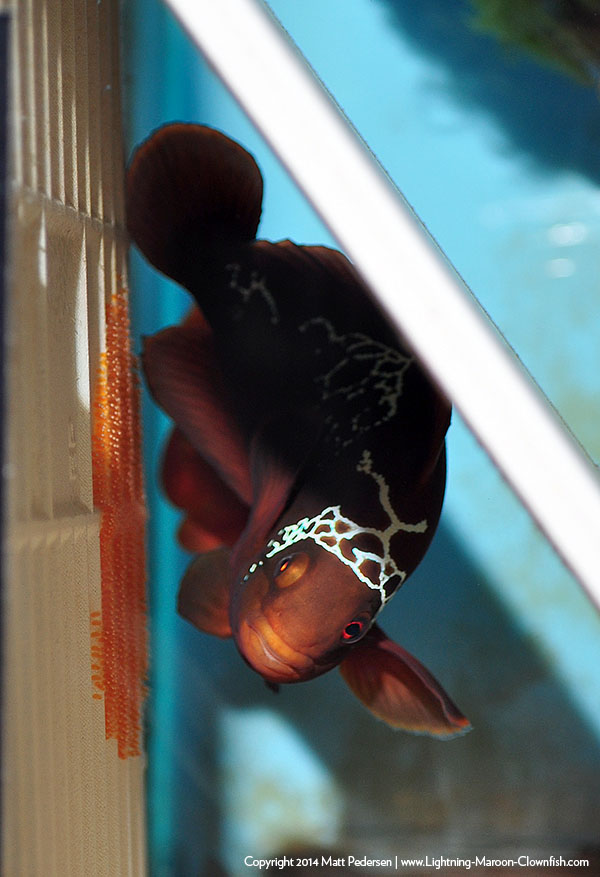
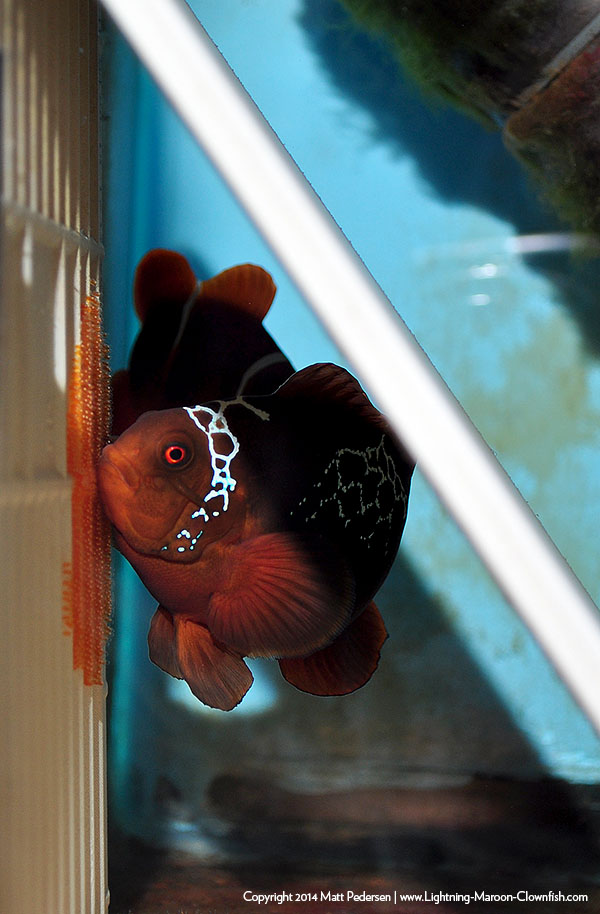

The larvae from spawn #42 that are still alive have largely settled out…it was a small group, but I’ll find a way to work with them. More importantly, it looks like LM X LM Spawn #2 might be over…I have not found any larvae in the BRT, so one more look, I repurposed it for Spawn #43. The eggs got the usual dip in H2O2, but started hatching during it, so they were moved straight into the BRT with 8 gallons of broodstock water and a few ML of RotiGrow Plus (only thing I had thawed…it’ll be fine for the first 24 hours and by that point I’ll have RotiGreen Omega up and running).
The most frustrating news is arguably LM X LM Spawn #3. So..to recap. Here was the first spawn:
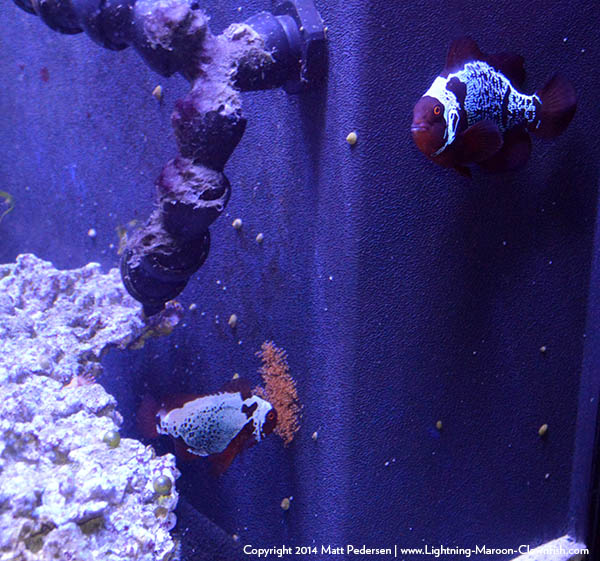
So…I took some proactive steps and tiled the back wall of the tank.
This was LM X LM (or LxL if you prefer) Spawn #2 on the first attempted hatch night:
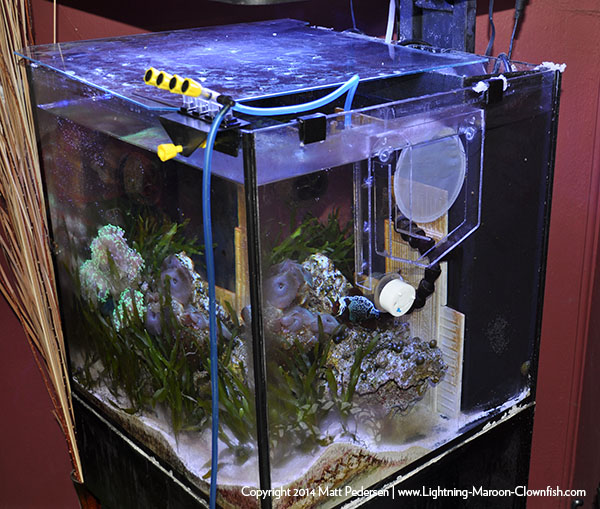
Yeah..that gray patch on the side..those are the eggs…
So that didn’t turn out obviously…so I tiled the side wall as well.
Here is Spawn #3, laid on 10/27/2014:
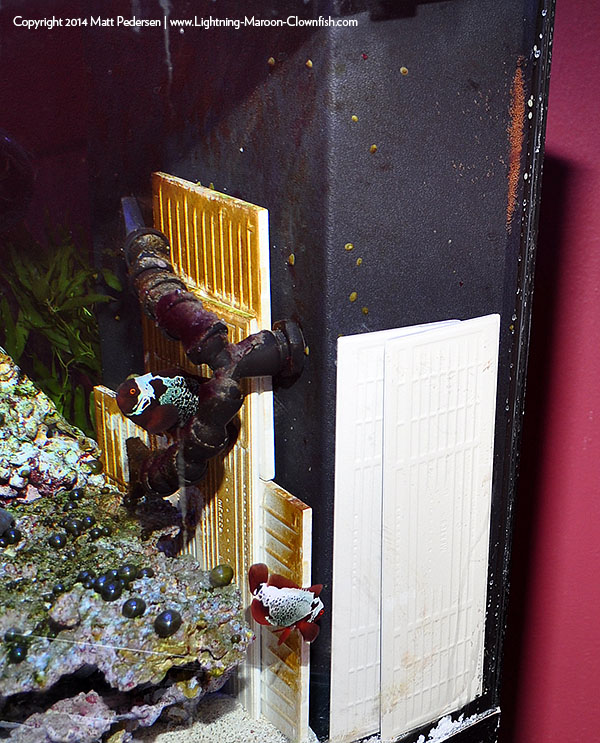
The internet shorthand FML seems somehow appropriate. Clearly the pair is flipping me the middle fin.
- About The Lightning Project
- Inventory of F1 PNG Lightning and White Stripe Maroon Clownfish
- F1 PNG Lightning Maroon Clownfish, BZLM1
- F1 PNG Lightning Maroon Clownfish, BZLM2
- F1 PNG Lightning Maroon Clownfish, FW1
- F1 PNG Lightning Maroon Clownfish, LM10
- F1 PNG Lightning Maroon Clownfish, LM11
- F1 PNG Lightning Maroon Clownfish, LM12
- F1 PNG Lightning Maroon Clownfish, LM13
- F1 PNG Lightning Maroon Clownfish, LM14
- F1 PNG Lightning Maroon Clownfish, LM15
- F1 PNG Lightning Maroon Clownfish, LM16
- F1 PNG Lightning Maroon Clownfish, LM17
- F1 PNG Lightning Maroon Clownfish, LM18
- F1 PNG Lightning Maroon Clownfish, LM19
- F1 PNG Lightning Maroon Clownfish, LM20
- F1 PNG Lightning Maroon Clownfish, LM3
- F1 PNG Lightning Maroon Clownfish, LM4
- F1 PNG Lightning Maroon Clownfish, LM5
- F1 PNG Lightning Maroon Clownfish, LM6
- F1 PNG Lightning Maroon Clownfish, LM7
- F1 PNG Lightning Maroon Clownfish, LM8
- F1 PNG Lightning Maroon Clownfish, LM9
- F1 PNG Lightning Maroon Clownfish, MD1
- F1 PNG Lightning Maroon Clownfish, MWP3
- F1 PNG Lightning Maroon Clownfish, WS17
- F1 PNG Lightning Maroon, EC1
- F1 PNG Lightning Maroon, GL1
- F1 PNG White Stripe Maroon Clownfish, BZWS1
- F1 PNG White Stripe Maroon Clownfish, BZWS2
- F1 PNG White Stripe Maroon Clownfish, BZWS3
- F1 PNG White Stripe Maroon Clownfish, WS10
- F1 PNG White Stripe Maroon Clownfish, WS11
- F1 PNG White Stripe Maroon Clownfish, WS12
- F1 PNG White Stripe Maroon Clownfish, WS13
- F1 PNG White Stripe Maroon Clownfish, WS14
- F1 PNG White Stripe Maroon Clownfish, WS15
- F1 PNG White Stripe Maroon Clownfish, WS16
- F1 PNG White Stripe Maroon Clownfish, WS4
- F1 PNG White Stripe Maroon Clownfish, WS5
- F1 PNG White Stripe Maroon Clownfish, WS6
- F1 PNG White Stripe Maroon Clownfish, WS7
- F1 PNG White Stripe Maroon Clownfish, WS8
- F1 PNG White Stripe Maroon Clownfish, WS9
- F1 PNG White Stripe Maroon, EC2
- F1 PNG White Stripe Maroon, FW2
- F1 PNG White Stripe Maroon, GL2
- F1 PNG White Stripe Maroon, MD2
- Lightning Breeding Directive
- Lightning Maroon Clownfish Links
- Home
- About The Lightning Project
- Inventory of F1 PNG Lightning and White Stripe Maroon Clownfish
- F1 PNG Lightning Maroon Clownfish, BZLM1
- F1 PNG Lightning Maroon Clownfish, BZLM2
- F1 PNG Lightning Maroon Clownfish, FW1
- F1 PNG Lightning Maroon Clownfish, LM10
- F1 PNG Lightning Maroon Clownfish, LM11
- F1 PNG Lightning Maroon Clownfish, LM12
- F1 PNG Lightning Maroon Clownfish, LM13
- F1 PNG Lightning Maroon Clownfish, LM14
- F1 PNG Lightning Maroon Clownfish, LM15
- F1 PNG Lightning Maroon Clownfish, LM16
- F1 PNG Lightning Maroon Clownfish, LM17
- F1 PNG Lightning Maroon Clownfish, LM18
- F1 PNG Lightning Maroon Clownfish, LM19
- F1 PNG Lightning Maroon Clownfish, LM20
- F1 PNG Lightning Maroon Clownfish, LM3
- F1 PNG Lightning Maroon Clownfish, LM4
- F1 PNG Lightning Maroon Clownfish, LM5
- F1 PNG Lightning Maroon Clownfish, LM6
- F1 PNG Lightning Maroon Clownfish, LM7
- F1 PNG Lightning Maroon Clownfish, LM8
- F1 PNG Lightning Maroon Clownfish, LM9
- F1 PNG Lightning Maroon Clownfish, MD1
- F1 PNG Lightning Maroon Clownfish, MWP3
- F1 PNG Lightning Maroon Clownfish, WS17
- F1 PNG Lightning Maroon, EC1
- F1 PNG Lightning Maroon, GL1
- F1 PNG White Stripe Maroon Clownfish, BZWS1
- F1 PNG White Stripe Maroon Clownfish, BZWS2
- F1 PNG White Stripe Maroon Clownfish, BZWS3
- F1 PNG White Stripe Maroon Clownfish, WS10
- F1 PNG White Stripe Maroon Clownfish, WS11
- F1 PNG White Stripe Maroon Clownfish, WS12
- F1 PNG White Stripe Maroon Clownfish, WS13
- F1 PNG White Stripe Maroon Clownfish, WS14
- F1 PNG White Stripe Maroon Clownfish, WS15
- F1 PNG White Stripe Maroon Clownfish, WS16
- F1 PNG White Stripe Maroon Clownfish, WS4
- F1 PNG White Stripe Maroon Clownfish, WS5
- F1 PNG White Stripe Maroon Clownfish, WS6
- F1 PNG White Stripe Maroon Clownfish, WS7
- F1 PNG White Stripe Maroon Clownfish, WS8
- F1 PNG White Stripe Maroon Clownfish, WS9
- F1 PNG White Stripe Maroon, EC2
- F1 PNG White Stripe Maroon, FW2
- F1 PNG White Stripe Maroon, GL2
- F1 PNG White Stripe Maroon, MD2
- Lightning Breeding Directive
- Lightning Maroon Clownfish Links
It’s been a few late late nights waiting for results on the Lightning X Lightning pair’s second spawn. Given that they had either spawned on Thursday, Oct 16th, or Friday, Oct. 17th, and going off of their parents 6 day hatch window, I set up their tank on the evening of Wednesday, Oct 22nd, to prepare for a possible hatch. This made sense given that it would either fit into the 6 day window if the eggs had been spawned on the 16th. No hatch was observed. On Thursday night, Oct 23rd, I encountered a very small hatch around 3 AM, a solid hour after lights out. But, nothing furhter happened, so the 10 or so larvae I had snagged simply sat in the snagger for the next 24 hours. And now, Friday night, the 24th, going into Saturday AM, it’s now just shy of 4:00 AM and I just finished “putting away” around 50-100 larvae from the F1 Lightning X Lightning pairing. I snagged them with the Vossen Larval Snagger…ultimately most totally bypassed the snagger, so I had to set up a LED crank-charge flashlight and manually attract the larvae to it. I also had to really crank up the flow rate faster than I was comfortable with, but if I hadn’t done that, I watched as most every larvae would swim back out of the trap once it realized what was happening.
I gave LxL Spawn #2 a very weak dosage of RotiGrow Omega (yes, I know this is not ideal, but I need to thaw out some new RotiGreen) and placed a half gallon’s worth of SS-strain rotifers (because I have those going now as well, thanks Mike) along with roughly 4.5 gallons of broodstock water in a BRT downstairs. Now we wait. Knowing how these fish tend to color up quickly, as long as I don’t massively screw up, we should get an idea of what’s going on very soon…eg. within 30 days.
The larvae from Lightning Maroon Spawn #42 did not do well despite what appeared to be a solid hatch on their second night. I’m guessing no more than 6 are still viable.
Back on Wednesday, Oct 22nd, 2014, the Lightning Maroon and her mate threw down Spawn #43. A beautiful nest. I have a lot of photos in the camera to post, but I’m still recovering from two back-to-back laptop rebuilds, so pictures are just going to have to wait for now.
It amazes me still that even with the entire story documented here for the world to see, there are still people out there who get it wrong, and sometimes blatantly so. I was alerted to a discussion on Facebook today in a semi-private forum, so I’ll refrain from naming names and keep it strictly to the inaccuracies. Within this discussion, all sorts of factually inaccurate statements were made, and so, it’s time for another round of “Lightning Maroon Mythbusting” – let’s set the record straight.
Myth – “My company ********* is a official retailer for sea and reef aquaculture the original and only breeders for the lightning maroon clownfish”
Fact – While the company in question may be an official retailer for Sea & Reef, even Soren Hansen himself wouldn’t be so bold as to claim that Sea and Reef was the “original” (aka. first) breeders of Lightning Maroon Clownfish, nevermind they are certainly not the “only” either. I’ll just raise my hand here and claim originality (which is indisputable) and for a long time, until Sea & Reef produced their 2nd generation fish, I was also the only 😉
Myth – “Soren from sea and reef aquaculture teamed up with Matt from bluezoo aquatics and they had joined forces..first pair to successfully breed was a joint venture.”
Fact – The first pair to successfully breed was my pair, here in Duluth MN, the wild-collected Lightning Maroon Clownfish with a wild collected normally patterned Maroon, both from Fisherman’s Island in PNG. Soren / Sea & Reef had nothing to do with the first pairing, and it certainly was not a “joint-venture” between myself and Sea & Reef or Soren.
Furthermore, I am not “from Blue Zoo Aquatics”…I am a customer of Blue Zoo Aquatics, but I do not work for them. I sell them the offspring of the actual “ORIGINAL” Lightning Maroon pairing, drop shipping them to Blue Zoo’s retail customers, but I am independent of Blue Zoo. There was no “joint-venture” in the production of the original F1 Lightning Maroon Clownfish offspring either – they were done by my own hand in my basement fishroom. Mike Doty, a good friend and fellow fish breeder who lives literally around the block, can be credited with helping rear the first, and some of the subsequent batches I’ve produced to date here in Duluth.
Myth – “Besides bluezoo lost their first breeding pair which one was a wild caught and one was a regular maroon”
Fact – Nothing could be further from the truth. In fact, NOTHING in that statement is even remotely true. It would seem that the person speaking (who is retailing Lightning Maroons from Sea & Reef) is attempting to create the illusion of rarity / exclusivity in order to drive sales.
But…let me pick it apart point by point. This statement implies that only one of the fish in the pair was wild caught. My pair = F0 X F0 (all wild caught). Sea & Reef’s initial pairing was one of my F1 offspring, paired to another F0 PNG white stripe maroon (per Soren Hansen’s communication with me).
Blue Zoo never had a breeding pair, so impossible to lose something they never had. Let’s assume that the “blue zoo” pair this person is referring to is in fact MY pair, the one which has supplied the offspring which Blue Zoo Aquatics retailed – that pair is still alive and well and producing…heck they just laid their 43rd spawn yesterday.
Myth – “So when they had a hybrid and Soren had an original wild caught they teamed up to bring them to wholesalers for sale”
Fact – I’m not even sure in what context the commentator / retailer is using the term “hybrid”, but I will say this – hybrid has multiple definitions. In the context it is typically thought of, being intraspecific hybridization (the offspring of two separate species) then no, no hybrids here. There are interspecific hybrids (at least one individual out there would prefer I use the term “population hybrids”) but at the end of the day, short of saying that ANY pairing of ANY fish of ANY type = hybrid, there is nothing hybrid about any of the breeding I did here, nor the breeding I’m aware of at Sea & Reef. The Lightning Maroon Clownfish is pure Premnas biaculeatus “PNG White Stripe”, but carries a mutant gene / allele which causes the unique stripe pattern alteration.
I think there’s also a lot of implication that there was direct collaboration between Blue Zoo Aquatics, Myself, and Soren Hansen, and I must clarify that. While I clearly have met Soren, have had many conversations with Soren, there was no coordinated effort on my part, or the part of Blue Zoo, to team up and bring Lightnings to wholesalers for sale. Soren Hansen purchased his F1 broodstock fish at public auction from me via Blue Zoo Aquatics – anyone could have bought that fish.
It was Soren Hansen who had the foresight to be a commercial breeder which procured additional wild PNG broodstock when it was available, on the gamble that there would one day be F1 Lightnings for him to work with at Sea & Reef. So, the credit for that goes squarely to Soren…he planned thoughtfully and then executed on that plan when the opportunity presented itself. I commend him for that foresight and a job well done.
Myth – “I will correct myself [Sea & Reef is] not the only breeder with the Lightning Maroons just the only ones that have quantity and the original strain”
Fact – Sorry, flat out “wrong”. While Sea & Reef does have the largest available quantity, they are not the “only ones that have….the original strain”.
I’ll avoid getting into the jargon of “strain”…as it doesn’t really apply well in this setting at this time anyway, but I will say this and I know Sea & Reef won’t argue. The “original” pair is here, still producing offspring. It is arguable that my stock has the “original” inherited gene, but we must understand that Soren’s offspring, which are 2nd generation Lightnings by using of my first generation offspring as a parent, should carry the exact same “lightning gene”. So they have the “original gene”, inherited from their parent, who got it from my original wild fish.
Ultimately, there will be many lines of Lightning Maroons produced by breeders around the planet, but unless another wild Lightning is discovered, collected, brought to market, and successfully bred, all Lightning Maroon Clownfish will owe their unique mutant gene to the original wild fish which resides here in my basement to this day.
Now, whether other breeders will keep their Lightning Maroon lineages true to the PNG provenance is another story, and that one day could be a bone of contention (eg. anyone hybridizing Lightnings with Gold Stripe Maroons, or looking at white stripe broodstock outside the PNG provenance). Sea & Reef has respected the PNG provenance in their lines (both Morse Codes and Lightnings), I have as well, and I’m hoping that all other breeders will do so, because it does matter in the long term when it comes to conserving natural biodiversity.
Opinion – “You can pay 2k plus for garbage or you can pay $3-400 retail and get yourself a quality maroon. Its a no brainer those that spent big bucks not even a year ago I’m sure feel like crap after seeing the prices of these from sANDr”
Fact – everyone is entitled to their opinion, but they’re not entitled to their own facts.
Spawn #41 was left to go for itself because the Lightning X Lighting Spawn #1 took priority. Unfortunately, by the time the eggs reached the anticipated hatch night, Wed, Oct 8th, there were only 7 eyed up eggs left. I attempted to harvest them by using a rigid air tube attached to a flexible tube to scrape and siphon them out…this broke one egg but the rest went through intact. By the next morning in the incubation cup (a half gallon specimen cup with broodstock water), the eggs were dead.
So back to the F0 Lightning X White Stripe pair; Oct. 11 they laid Spawn #42, and tonight, Friday, October 17th, 2014, I pulled the eggs and gave them the typical H202 Bath..about 11 minutes in, we (Paul Whitby of HighDefCorals is in town to speak at our club) noticed that larvae had begun to hatch, so the dip was ended and I placed the tile in the cleaned, readied 6 gallon BRT which had 5 gallons broodstock water and 1 gallon new water.
In other news, the Lightning X Lightning pair put down their second spawn somewhere between 5 PM on Thursday, Oct 16th and 4:30 PM Friday, Oct. 17th. It’s a much larger nest, which was expected. Despite having basically tiled the entire backside of the aquarium, the pair thwarted my efforts by spawning around the corner in a tight area of black plastic background. I don’t know when the proper “harvest” date will be for these fish; I’ll like try my Vossen Larval Snagger this time around. But I also know that I’ll be putting even MORE tile into their tank now 😉
So yeah…October 2nd, I’m just walking by the tank and I see this…

We are about to embark on the next exciting chapter of the Lightning Maroon Clownfish and genes. My hypothesis is that the Lightning gene is partially dominant or dominant. The offspring from this spawn, if successfully raised, will yield important answers that may shed new light on the genetics at play. Will we see something NEW come out of this? Well..I certainly hope so and it looks like I’ll get to name it!
Let’s give that a closer look:
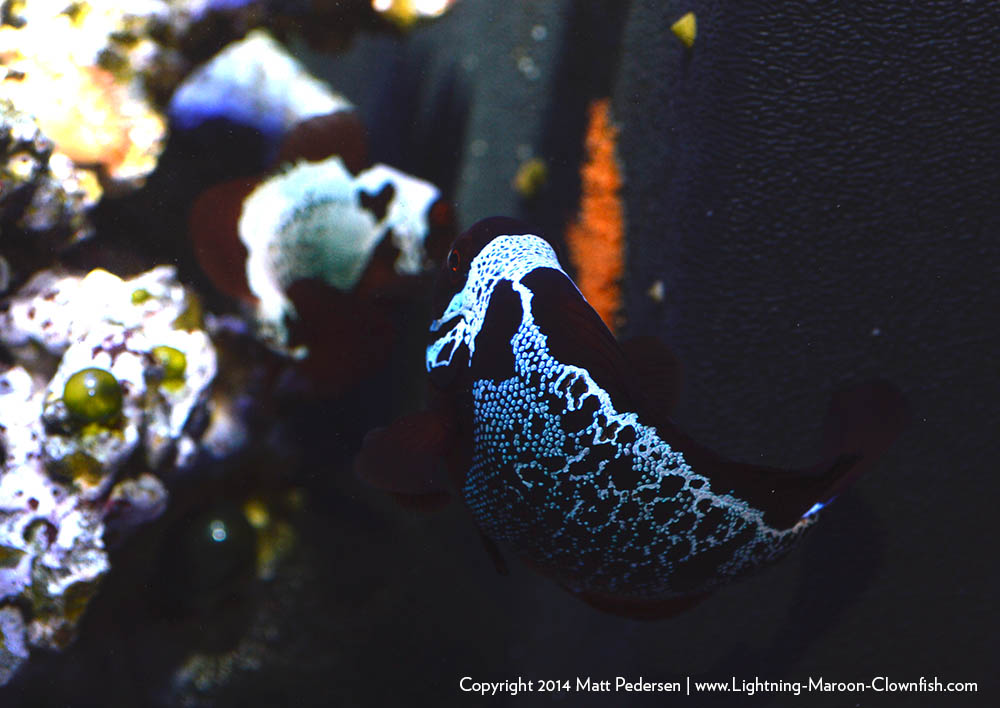
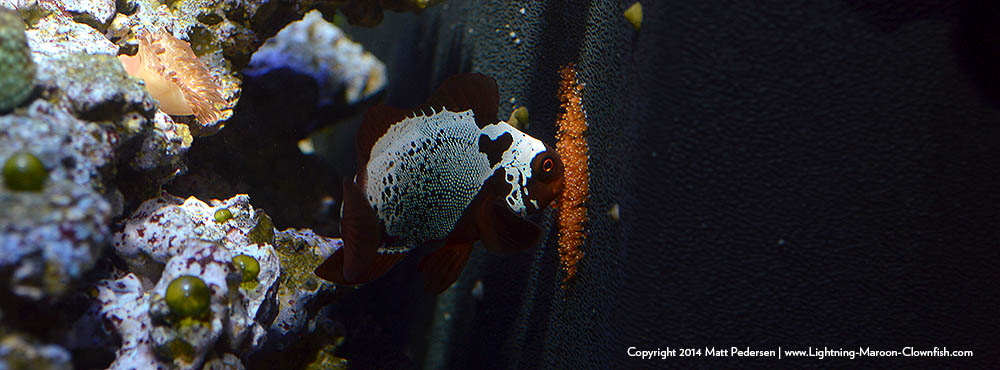
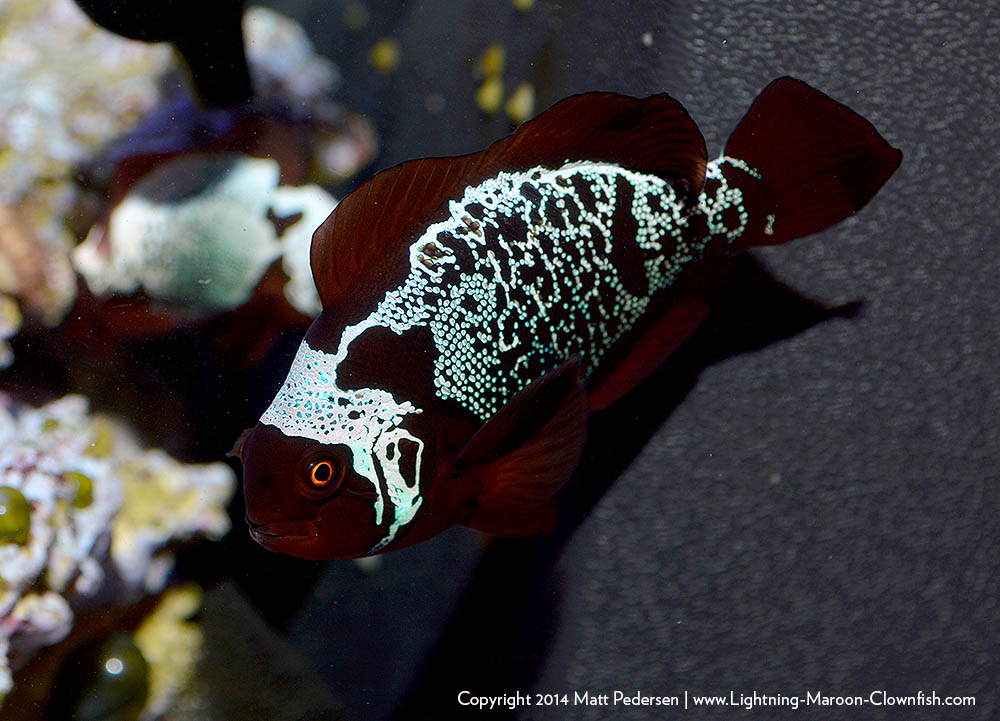
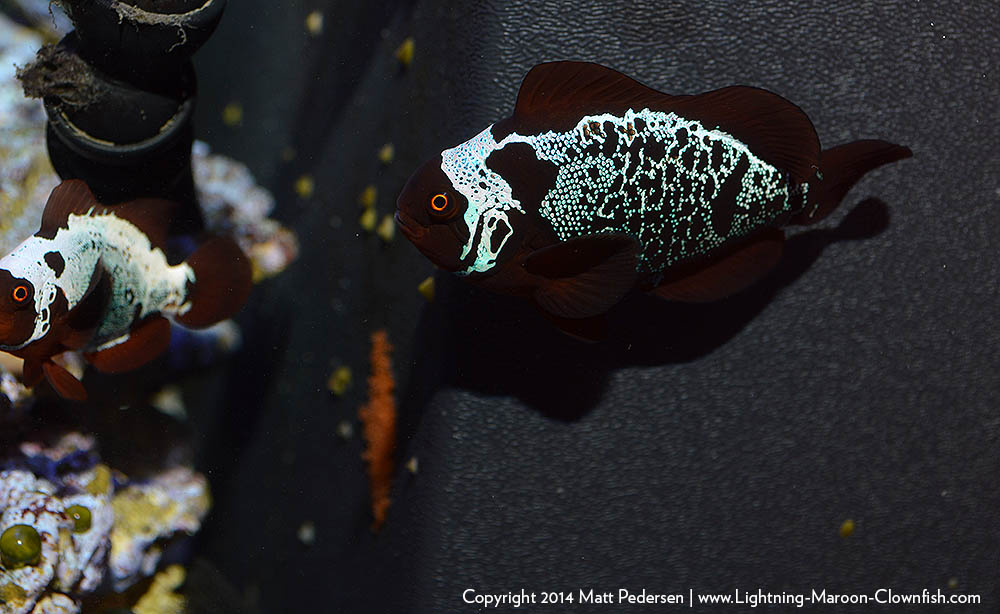
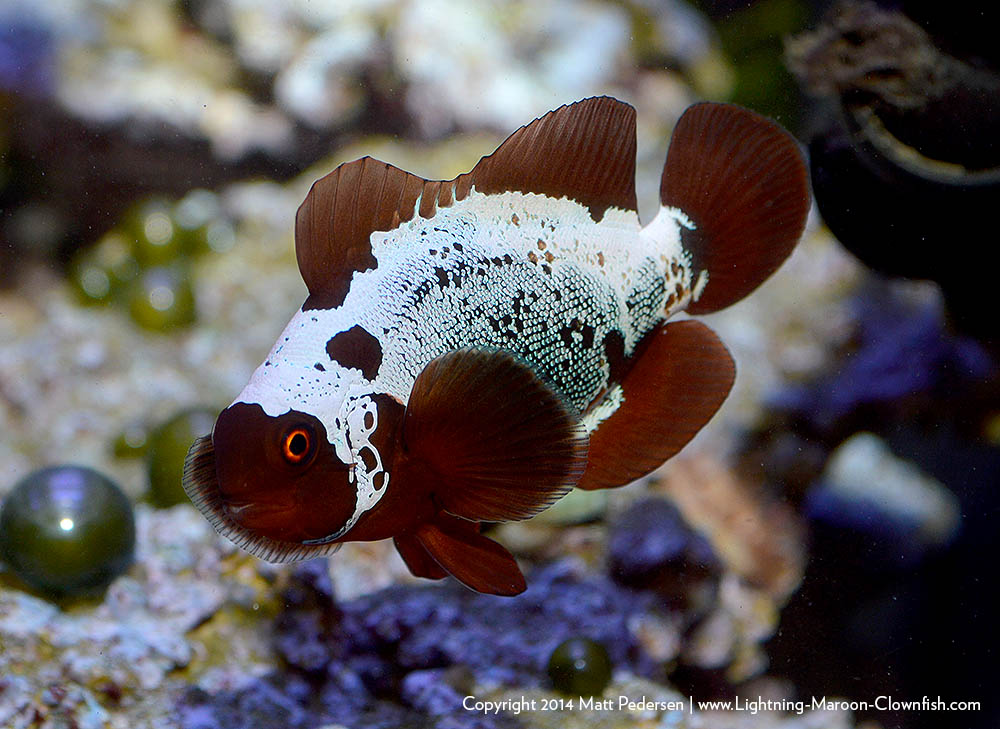

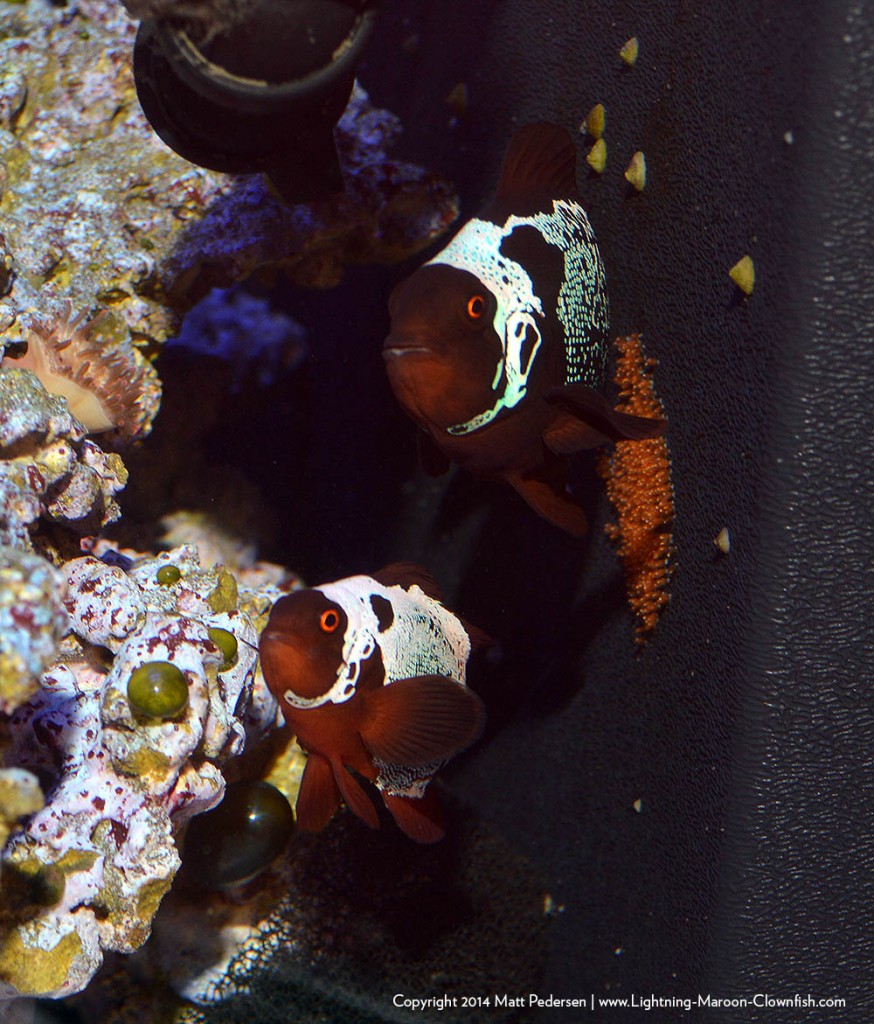
Yup, one of those quick little posts…9-29-2014, Lightning Maroon Spawn #41 was put down…and we’re back on the “slanted” tile instead of the vertical one.
And alongside, the loaner pair of A. melanopus from Mike Doty also spawned on 9-29 as well…time to get me some MBI points!
That is all…
Before I even had a chance to post it here on the Lighting Project, Lightning Maroon #20, aka LM20, was listed for $999.95 and sold via the Blue Zoo Collector’s Choice section of their website. This is likely the venue for at least the next few fish I release, which will remain drop shipped directly from Duluth, MN at this time. The best way to be notified of future offerings will be to get on the Blue Zoo Newsletter (subscribe on their homepage, left column) and watch the Lightning Maroon Clownfish Facebook Page.
White Stripe Spawn #3 seems to have hatched earlier than expected. I was looking at the tank on Saturday, 9-13, which would’ve been the day to pull the tile, but the eggs were already gone. So they may well be on a 5 day schedule?!
Meanwhile, Lightning Maroon Spawn #40 was laid on 9-10-2014. I’ll be out of town late this week, which means I won’t be able to properly tend to baby lightning maroons. So this batch, like the last, will be left to hatch and move one. I believe I’ll be in a good position to deal with Spawn #41 if the fish are back on schedule.
That’s all.
I skipped worrying about the hatch on the last spawn…we simply have too much going on in our lives at the moment to effectively start rearing a batch of clownfish this week. Meanwhile, on 9/7/2014, the White Stripe Maroons, the unrelated F0 pairing, put down another nest, but small. I’ve yet to see a really large nest out of these guys, and their spawning is not consistent yet. I will try to raise this batch so I have outcross material…and down the line I may finally opt to split this pair up to make three foundation lines of Lightnings in my fishroom.
That’s all!
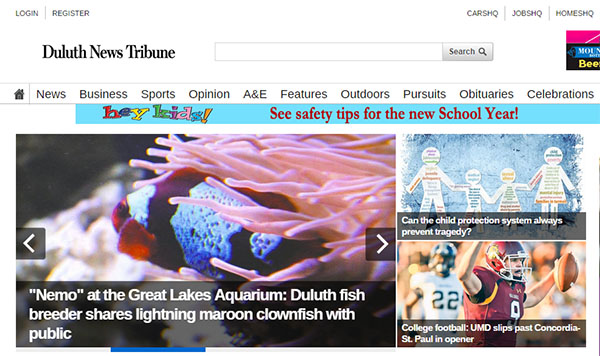
The Lightning Maroon Clownfish at the Great Lakes Aquarium enjoy a brief feature on the homepage of the Duluth News Tribune on the morning of Sept. 7, 2014
The Lightning Maroon Clownfish offspring (GL1 and GL2) I donated to the Great Lakes Aquarium in 2013, are now officially on display.
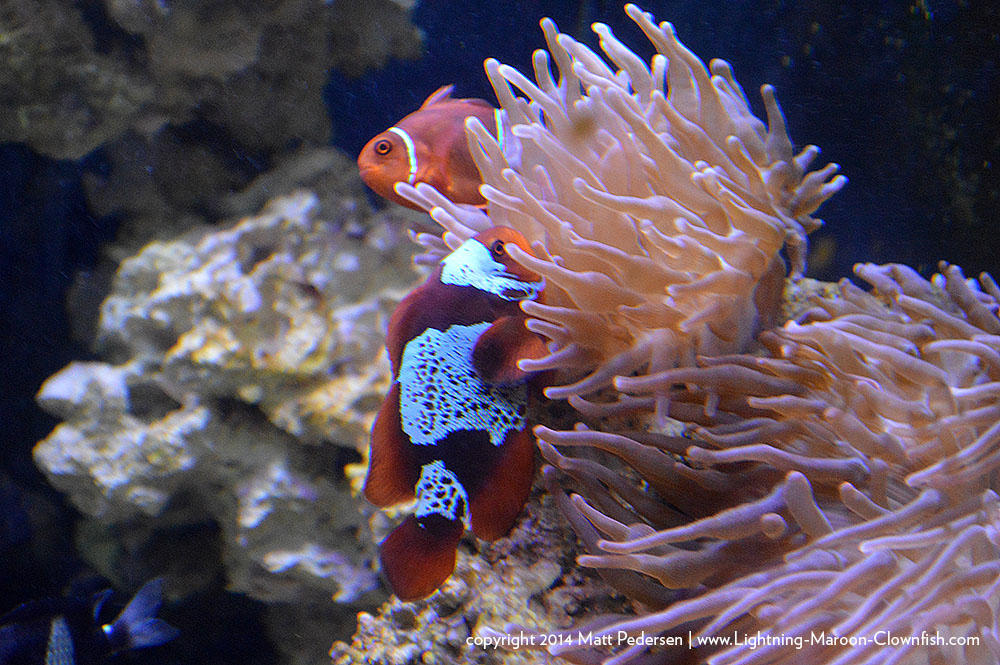
GL1, the lower fish, foreground, carries the Lightning gene; it’s whit striped mate, above, does not.
Late on Saturday evening, one of my FISHING friends (not to be confused with FISH friends) posted on Facebook that the official story had run online; this Saturday, September 7th, 2014, the Duluth News Tribune is running a story by Alysee Shelton about the Lightning Maroon Clownfish and its mate, which are now on display at the Great Lakes Aquarium here in Duluth, MN. You can ready the story online here for the next coupld days – http://www.duluthnewstribune.com/content/nemo-great-lakes-aquarium-duluth-fish-breeder-shares-lightning-maroon-clownfish-public – Now, I should point out that the article isn’t 100% accurate. As you all know, I like to indulge in a bit of mythbusting (aka. Fact Correcting) here at the Lightning Project…the Duluth News Tribune will “suffer my wrath” (meant very tongue in cheek, affectionately), receiving a healthy dose of disambiguation just like everyone else.
For starters, the fish were actually delivered to the GLA on August 2nd, 2013, which means they were behind the scenes for just over a year before being put on display, not the “6 months” the article mentions. The year behind the scenes is perfectly understandable given that aquarists were VERY busy with the new “Shipwrecks Alive” exhibit that was being put in place in the rotating exhibit hall to replace the “Masters of Disguise” exhibit, which was the replacement for the “Seahorses” exhibits I never got to see…but there’s another reason which I’ll cover in a second.
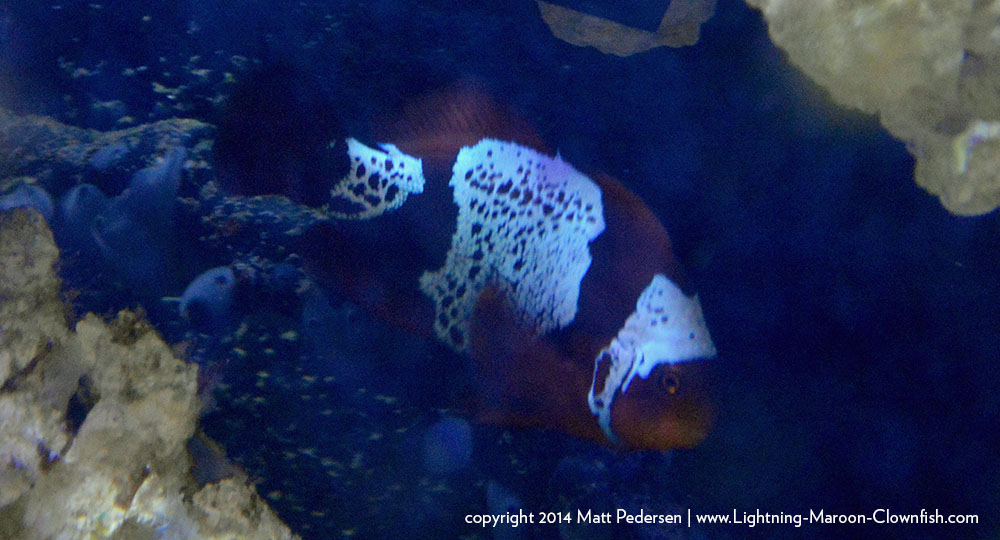
I would remind readers that while this article suggests that “[SEASMART] decided to send that fish to Matt Pedersen, an international marine aquarium fish breeder in Duluth.”, that it was actually a) Blue Zoo Aquatics who had the final say in whether I would receive the fish (although my understanding is that all parties felt it was a good move) and b) they didn’t just “send” me the fish…yes, the rumors still persist that I was just “given” the Lightning Maroon!
Jay Walker is a great guy and Operations Manager at the aquarium; I LOVE that QUARANTINE, a practice that too many aquarists skimp on, was mentioned at great lengths in this media coverage and attributed to Walker. To pull a shortened version of Walker’s comments, “quarantine lasts for a minimum of 30 days, and within this time we do prophylactic treatments for diseases, developing husbandry practices and observations. This process can last for more than 30 days depending on the situation.” I wish to just elaborate here, that in the case of the Lighting Maroon Clownfish and its normally patterned mate, a BIG part of the actually year-long “quarantine” was the process of size-differentiation leading into successful pairing (“Mating” as the Duluth News Tribune called it in reference to when I first paired the wild fish here in my dining room…and no, not pairing with wine…). Yes, the GLA didn’t try to accomplish pairing these sibling fish in just a month or two…

Shelton’s article also glosses over the actuality of numbers a bit, but that’s more due to the brevity of the piece and a word we’re all forced to deal with. For example, “produced their offspring, classified as lightning maroon clownfish, on June 29, 2012.” As most Lightning Project followers already now, only about 50% of the offspring wind up displaying the mutated phenotype (appearance) and therefore, only about half of them are actually “Lightning” Maroon Clownfish. I should mention this because one of my worst fears is that someone picks up this story and starts talking about the fish as if they are a NEW SPECIES (which they are certainly NOT). I will also point out a subtle fact that cannot be discerned from the article as written – the GLA only has one Lightning Maroon Clownfish; it is paired with a White Stripe (Normal) sibling. When you get caught up using a word like fish (same when singular or plural) I realized, as I read this piece, that you never can really tell whether you are talking about one, two, or for that matter dozens/hundreds/thousands.
The article went on to state that “Great Lake Aquarium officials believe they are the first aquarium in the world to have these fish.” – I’ll emphatically say that “believe” suggests perhaps more room for doubt than is actually there. When it comes to “firsts” – and for a small public aquarium like the Great Lakes Aquarium, firsts DO matter – I am reasonably confident that they were the first public aquarium to have possession of a Lightning Maroon Clownfish (I could go back and check my records just to be 100% sure). Regardless of that, to the best of my knowledge, I am very confident that they can rightfully claim to have been the first and (to date) only public aquarium in the world to have this unique form on public display. I can say this with reasonable certainty given that I know where all the Lightning Maroons in my fishroom have gone…so unless someone “changed their minds”, I would presume that the Lightning Maroons that were sold in 2013 and 2014 are still in the same breeding programs they were when originally purchased…and not on public display. Will other aquariums in the future display a Lightning Maroon Clownfish? Perhaps…but I am proud that the GLA stands apart in the world, at least for now.
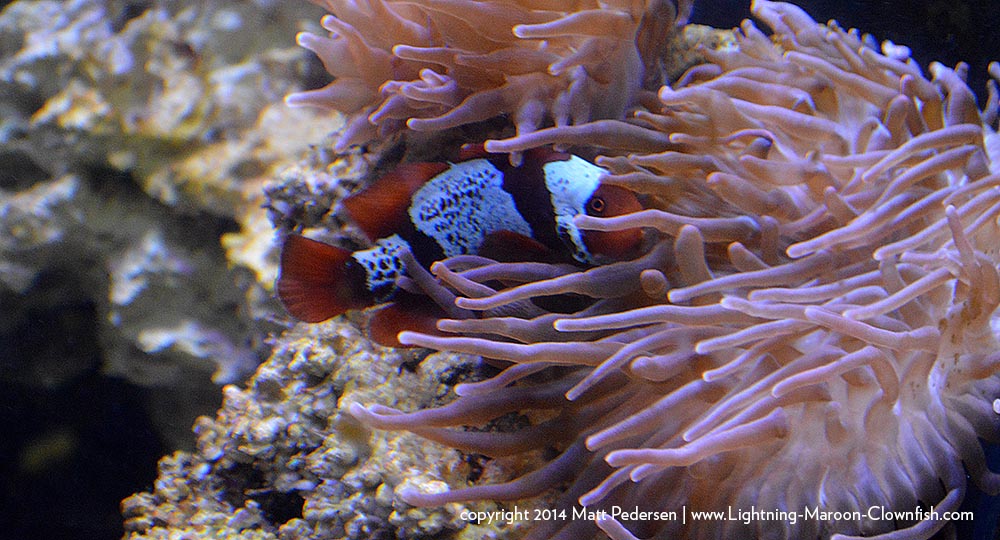
I am truly delighted that the fish are on display, in the capable hands of the aquarists at the GLA. And yes, anyone who feels the current retail pricing is just too much to spend on a fish, you can now see one for the price of admission at a unique public aquarium on the shores of St. Louis Bay on Lake Superior. My special thanks for Alysee Shelton for taking the time to craft her article for the Duluth News Tribune – in a few hours I hope to see it in print!
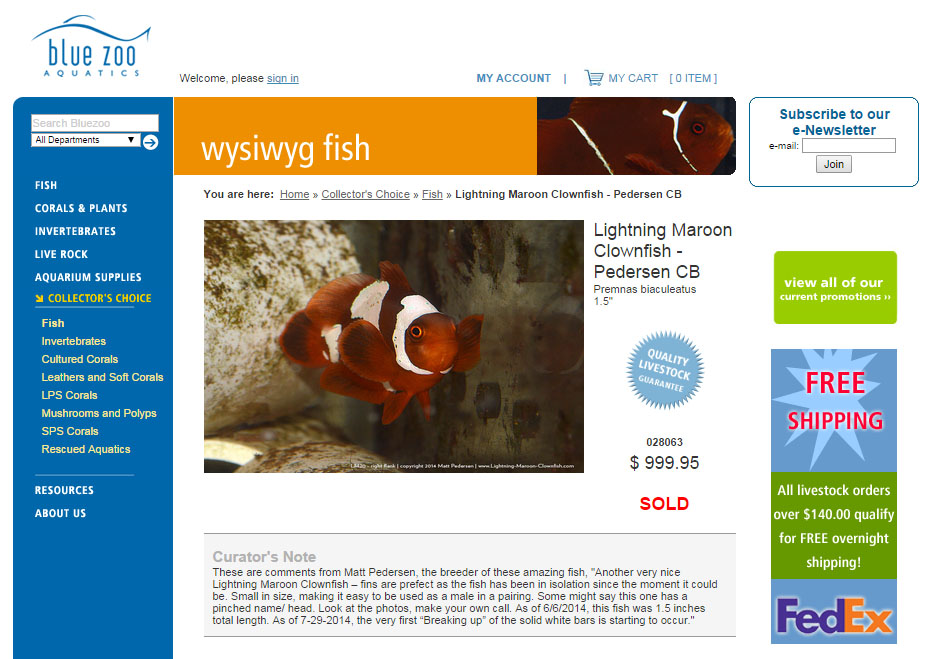
Recent Comments